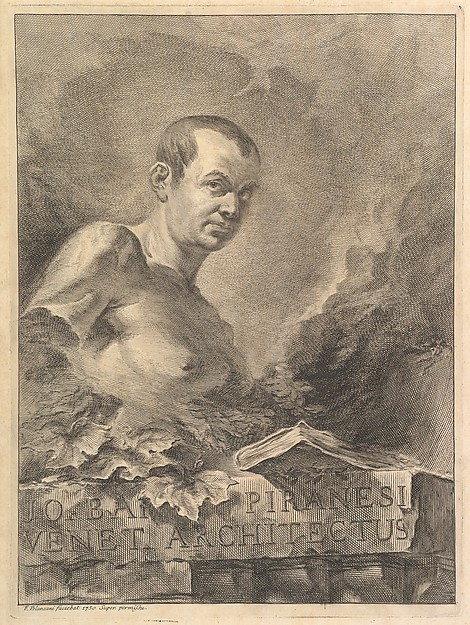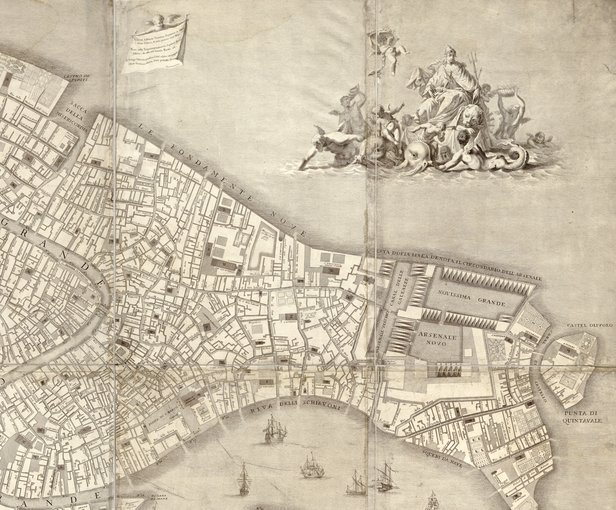The Life of Piranesi

Francesco Polanzani, Portrait of G.B. Piranesi in imitation of an antique bust, 1750, engraving (Metropolitan Museum of Art)

Lodovico Ughi’s 1729 Map of Venice, 1729, engraving (World Digital Library)
Sarah Kain
Giovanni Battista Piranesi (1720-1778) was born at Mogliano Veneto in Italy. His father was a stonemason and a master builder, and his mother was the elder sister of Matteo Lucchesi (1705-1776), a renowned architect and engineer who had connections in aristocratic circles.1 Piranesi’s family expected him to be an architect, and his upbringing in the architectural world of Venice was foundational in his future achievements.2 The Venice in which Piranesi grew up introduced him to the architecture of the theatrical stage through the various productions he worked on, an experience that would be influential to the style he developed. Piranesi learned to perfect the art of stage design, discovering how to render light and shade with dramatic effect, draw architecture from unique angles, and take risks with perspective.3
Piranesi was captivated by the antiquity of Rome from a very young age, visiting the ancient city as an inexperienced draughtsman aboard an ambassadorial train. During his time in Rome, he drew everything: temples, palaces, bridges, aqueducts, and all of the fragments of Rome’s past which were, at the time, only just being uncovered and restored.4 At twenty-five (1745), Piranesi received an offer of work from a publisher in Rome and returned to settle there for life. In his early years in Rome, he published almost no artwork and spent the majority of his time observing and sketching ancient ruins and styling imaginary reconstructions.5 Soon after his arrival in Rome, Piranesi apprenticed himself briefly to the Sicilian Giuseppe Vasi (1710-1782) the most famous producer of etched views of Rome, which he supplied to Grand Tourists as a lasting souvenir.6 At thirty two, Piranesi married Angela Pasquini. He put his wife’s dowry towards a supply of huge copper plates, allowing him to establish and sustain his independent career as a view-maker.7 Piranesi, in collaboration with some young French artists from the Academy, began to distribute his own etchings with a series of small vedute over several decades.8 In the next thirty-five years, Piranesi would etch over a thousand big plates. He made a substantial fortune by selling his huge views, and some of his copper plates are still used in Rome today.9 Piranesi died in 1778 in Rome after a long decline in health. Even though Piranesi lived in Rome for the majority of his life, and used Rome as his main source of inspiration, he stated frequently that he considered himself a subject of the Republic of Venice. The title page of his famous Vedute di Roma is taken up by the words “Drawn and engraved by Giambattista Piranesi Venetian architect,” signifying the importance Piranesi assigned to his Venetian origins.10
_______________________________________________________________________________________
1Jonathan Scott, Piranesi (London: Academy Editions, 1975), 7.
2Michele Di Lucchi, Adam Lowe, and Giuseppe Pavanello, The arts of Piranesi: architect, etcher, antiquarian, vedutista, designer (Madrid: Factum Arte, 2012), 29.
3Mayor, A. Hyatt. "Piranesi." The Metropolitan Museum of Art Bulletin 33, no. 12 (1938): 279-84. doi:10.2307/3256393, 279.
4Scott, Piranesi, 10.
5Mayor, “Piranesi,” 279.
6Wendy Thompson. "Giovanni Battista Piranesi (1720–1778)," Heilbrunn Timeline of Art History | The Metropolitan Museum of Art, accessed May 07, 2017. http://www.metmuseum.org/toah/hd/pira/hd_pira.htm.
7Mayor, “Piranesi,” 280.
8Cara Dufour Denison, Myra Nan Rosenfeld, and Stephanie Wiles. Exploring Rome: Piranesi and his contemporaries (Cambridge, Mass: MIT Press, 1994), 26.
9Mayor, “Piranesi,” 279.
10Lucchi, Lowe, Pavanello, The arts of Piranesi, 29.